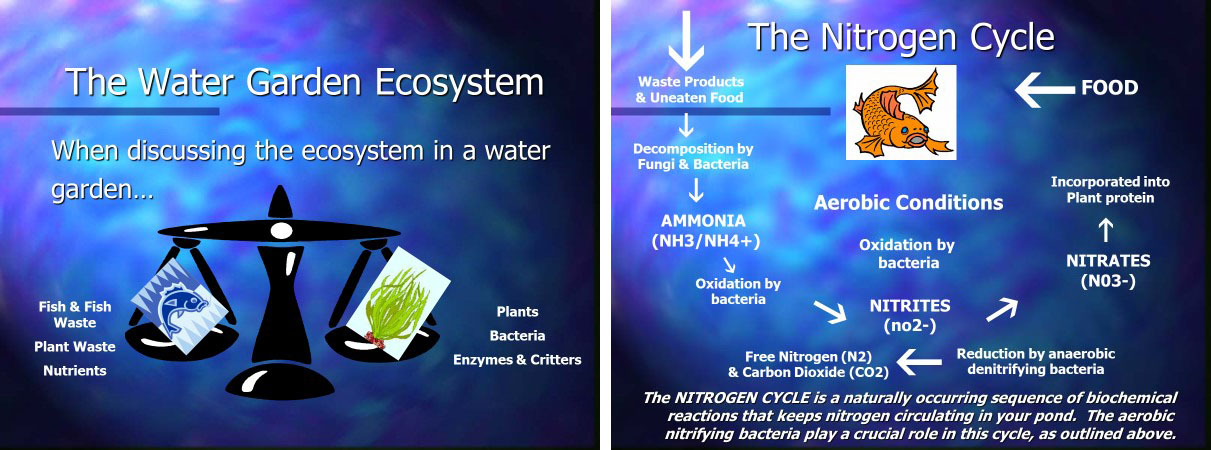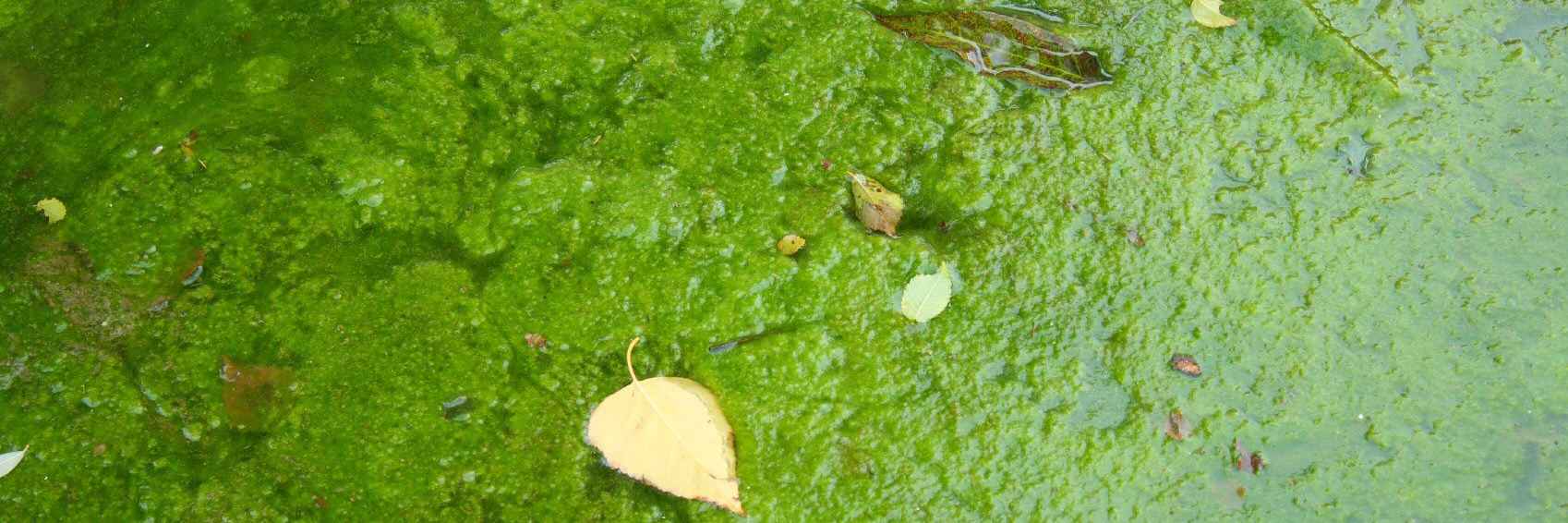Pond Algae Solutions for Green Water
Green Pond Water? We have the Solution!
So, your pond water has turned green. You've changed the water and it turned green again.
What do you do now? Get a bigger pump? More fish? A larger fountain? More bacteria?
What exactly causes your pond water to turn cloudy, then cloudier, then light green, and eventually pea-soup green? Single cell algae are the culprit. As they multiply and clump together, algae turns your water greener and greener. But don't give up. After decades of experience in pond algae treatment, our team of experts at Hoffman's Water X Scapes has the knowledge, experience, and tools & products to help solve your situation.
Not All Algae is Bad
There are thousands of varieties of algae that grow in all regions of the world, including the North and South Poles AND in deserts.
We group them into 2 families – single-cell varieties and multi-cell varieties - commonly referred to as string algae, filamentous algae or pond scum.
Most of the common varieties of algae are not toxic or harmful in your pond. In fact, some algae can actually be healthy for your pond and fish.
Let's look at some of the facts surrounding algae blooms. If you have a body of water (in a bucket, a pool, a pond, etc.), certain nutrients, temperatures above 50 degrees Fahrenheit, and sunshine, something green is going to grow. in that body of water. Unless you "nuke it" (chlorine, copper products or some other chemical), something green is going to grow. Period.
You have a choice about what you are going to grow, but not about if something is going to grow. So how do we control green pond-water algae?
One. Control the nutrients going into the pond and remove nutrients from the pond.
Two. Maintain the pond Ecosystem – a balance between fish, plants, critters, bacteria and other living organisms within your pond. See the illustration of The Water Garden Ecosystem below..
Three. The Nitrogen Cycle is part of your pond's ecosystem and must be taken into consideration. Feeding the fish - or over feeding the fish - affects the nitrogen cycle.

By maintaining a balanced Ecosystem including the Nitrogen Cycle, clear clean water is very easily achieved. Improper cleaning of the biological filter or the pond can affect the nitrogen cycle. The number and type of plants within the pond itself affects the nitrogen cycle, and so on. Please see the illustration on the Nitrogen Cycle.
Here is a list of questions and information to help evaluate your pond and determine its' needs regarding the nitrogen cycle..
How large is your pond?
To determine the approximate number of gallons of water in your pond, use this formula:
Average Length X Average Width X Average Depth = Cubic Feet of Water.
Cubic feet of pond water X 7.5 (gallons of water per cu. ft.) = Gallons of water in your pond.
4,500 cubic feet of water X 7.5 = 33,750 gallons in your pond.Example: Pond is 50 feet long, 30 feet wide, and 3 feet average depth = 4,500 cubic feet of water.
How many fish are in your pond and how large are they?
The larger the fish, the more you feed them, hence introducing more nutrients into the pond in the form of fish food and fish waste.
A. I recommend that a newer pond, less than a year old, should have no more than one inch of fish per square foot of service area. A more established pond, if balanced correctly, can have several more inches of fish per square foot (sq. ft.) of surface area, possibly up to 6 or 7 inches per sq. ft. of surface area.
B. Koi pond fish (vs. goldfish) produce much more waste and become much larger, so it is recommended to cut these recommendations in half.
C. Fish will grow and they will multiply. At some point you may need to fine a new home for some of your fish.
How often and how much should you feed your pond fish?
Fish should only be fed when spring, summer and fall water temperatures are consistently above 50 degrees Fahrenheit. For more information, please see my Fish Feeding Info blog post here.
Fish in your pond do not necessarily have to be fed, depending on the number and size of fish, the size of your pond and the availability of other food (plankton, insects, etc.). The quality of your pond fish food will also have a large effect on the clarity of your water. I recommend feeding your fish once a day, what they will eat completely, in 3 to 5 minutes. Remove any uneaten food. Left in the pond, this food will decay, cause algae problems and possibly create other health issues for your fish. Or, feed your fish two or three times per day, but only feed them what they will eat in 1 to 2 minutes each time.
What type and size of pond filtration system do you need?
A. Mechanical pond filtration systems takes particles, such as leaves, string algae, twigs, etc. out of the water as well as preventing them from clogging up your pump. The pump cover is a basic mechanical filter. There are many other types of mechanical pond filters such as foam filters, lava rock filters, part of a gravity filter, pressurized filters and skimmers.
B. Biological pond filtration consists of good types of bacteria that consume/break down ammonia, nitrites, organic matter such as leaves, mulch, fish waste, etc. Biological filters can be small filters in the bottom of the pond, or else pressurized, gravity, up-flow falls boxes, water fall filters, etc.
My explanation of biological pond filtration is:
1. A type of container that will hold a material or media that has a lot of surface area, such as lava rock, plastic wheels or filter material. Good pond bacteria will cling to the surface of these materials and start to multiply as food (ammonia and nitrites) is made available to them. This is a bacteria colony.
2. Water from the pond then circulates through the filter media 24/7 throughout the spring, summer and fall while water temperatures are above 40 degrees F.
3. In the fall, as fish waste, which is primarily ammonia, decreases due to the fish’s metabolism slowing down, the bacteria die and cannibalize each other. Late fall and winter are the only time of the year when I recommend cleaning the filter. In the spring, when fish waste, begins to increase, the bacteria in the pond and biological filter will begin to multiply. Seeding, or adding bottled, cultured bacteria is recommended to speed up the growth or cycling of the bacteria. It takes 4 to 6 weeks and sometimes longer for pond bacteria to cycle, depending on water temperatures, pH and other factors.
The size of your pond water pump will also have an effect on the effectiveness of the biological filter.
C. Plant filtration is considered the best and most natural of all filtration methods for ponds, lakes and water features. Used in combination with mechanical and biological filtration, pond plants will remove nutrients and toxins from the water - effectively starving the single cell algae. Water will be clearer, cleaner and healthier for all occupants of the pond. Plants will not get rid of string or filamentous algae, but it will slow down its growth. At the end of the season, you want to remove the greenery from most of the aquatic plants so that it does not die, fall into the pond, decay and re-introduce this nutrient back into the pond.
D. Are there other sources of nutrients coming into the pond to be aware of and consider?
1. The water you add to your pond to replace the water that has evaporated has nutrients and minerals in it. It either came out of a reservoir or lake - which also has nutrients in it. Or, it came out of a well - which has minerals and some nutrients in it.
2. Leaves, needles, or seed pods dropping into the pond can add a lot of nutrients.
3. Has mulch around the pond built up from yearly or bi-yearly applications. Is mulch and decomposed mulch or muck running into the pond when there is a heavy rain?
4. Occasionally, rocks or stones containing phosphate is put into a pond. Most of this stone is sold in bags in the form of white or yellow gravel that is 3/8” to 1” in diameter
5.. Nitrates are brought into our ponds during thunderstorms.
6. Potted aquatic plants that leach fertilizer or are potted in a peat moss-based soil versus a clay-base topsoil.
The solution to keeping your pond water not only clear, but also clean and healthy for your fish and other aquatic guests, is to control the amount of nutrients coming into your pond, have the correct filtration and pump in place, and have enough of the correct plants in-place to remove unwanted nutrients.
Another solution is to contact Hoffman's Water X Scapes and allow us to help you improve the quality and clarity of your pond water. We are here for you and we love ponds and water gardens 24/7 and every month of the year! Did we mention that we carry a great line of pond water treatments to assist you with various pond water scenarios?
Thanks for visiting, and for reading.
